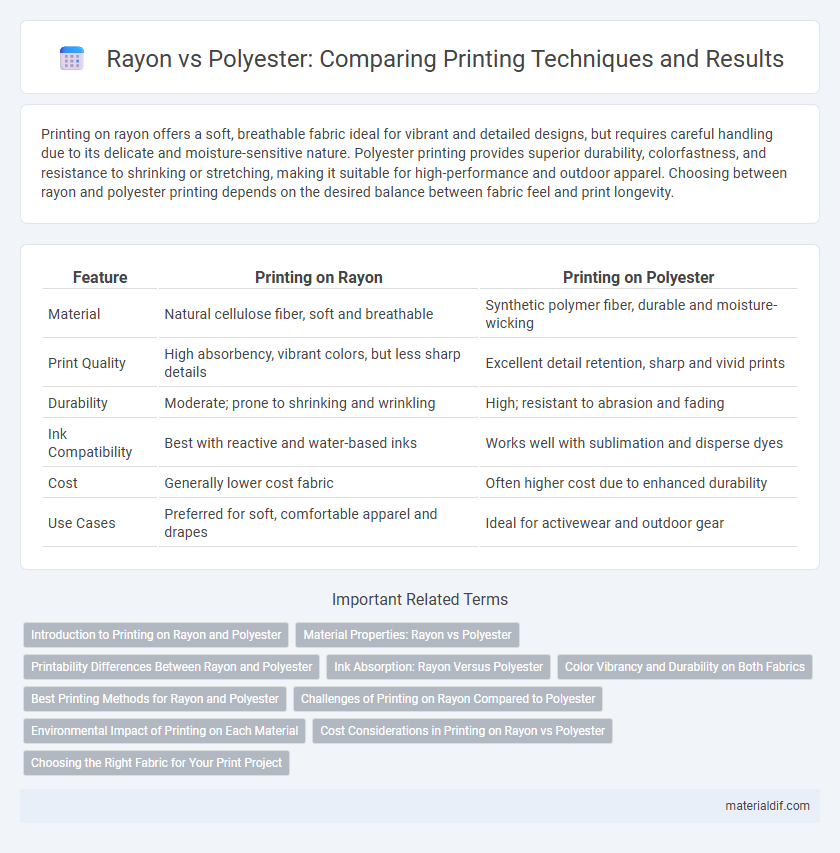Printing on rayon offers a soft, breathable fabric ideal for vibrant and detailed designs, but requires careful handling due to its delicate and moisture-sensitive nature. Polyester printing provides superior durability, colorfastness, and resistance to shrinking or stretching, making it suitable for high-performance and outdoor apparel. Choosing between rayon and polyester printing depends on the desired balance between fabric feel and print longevity.
Table of Comparison
| Feature | Printing on Rayon | Printing on Polyester |
|---|---|---|
| Material | Natural cellulose fiber, soft and breathable | Synthetic polymer fiber, durable and moisture-wicking |
| Print Quality | High absorbency, vibrant colors, but less sharp details | Excellent detail retention, sharp and vivid prints |
| Durability | Moderate; prone to shrinking and wrinkling | High; resistant to abrasion and fading |
| Ink Compatibility | Best with reactive and water-based inks | Works well with sublimation and disperse dyes |
| Cost | Generally lower cost fabric | Often higher cost due to enhanced durability |
| Use Cases | Preferred for soft, comfortable apparel and drapes | Ideal for activewear and outdoor gear |
Introduction to Printing on Rayon and Polyester
Printing on rayon requires careful consideration of its delicate, absorbent fibers, which absorb dyes deeply, resulting in vibrant, soft prints but demand gentle handling to prevent damage. Polyester, a synthetic fabric, allows for more durable and colorfast printing through methods like sublimation, which chemically bonds dye to the fibers, producing sharp, long-lasting images. Understanding the distinct fiber properties of rayon and polyester is crucial for selecting the appropriate printing technique to achieve optimal quality and durability.
Material Properties: Rayon vs Polyester
Rayon fibers offer superior breathability and a softer, more natural feel compared to polyester, making it ideal for lightweight, comfortable garments. Polyester, a synthetic fiber, provides greater durability, resistance to wrinkles, and colorfastness in printing processes. The porous structure of rayon absorbs inks differently, resulting in vibrant, though sometimes less sharp, prints, while polyester's smooth surface enhances print precision and longevity.
Printability Differences Between Rayon and Polyester
Printing on rayon offers vibrant color absorption and a soft, natural feel due to its cellulose-based fibers, but it requires careful handling to avoid shrinkage and print distortion. Polyester, a synthetic fiber, provides excellent print durability and colorfastness, making it ideal for sublimation printing with sharp, long-lasting designs. Differences in fiber composition result in rayon favoring water-based or reactive dyes for rich prints, while polyester performs best with heat transfer or disperse dyes for optimal print quality.
Ink Absorption: Rayon Versus Polyester
Rayon exhibits superior ink absorption compared to polyester, resulting in more vibrant and saturated prints due to its natural cellulose fibers. Polyester's synthetic composition limits ink absorption, often causing prints to appear less vivid and requiring specialized inks like sublimation for optimal results. This fundamental difference significantly affects print quality, durability, and color richness between rayon and polyester fabrics.
Color Vibrancy and Durability on Both Fabrics
Printing on rayon offers rich color vibrancy due to its smooth, absorbent fibers that allow dyes to penetrate deeply, resulting in vivid and radiant prints. Polyester printing, however, excels in durability with its synthetic composition, ensuring colors remain vibrant and resistant to fading even after multiple washes. While rayon provides superior softness and a natural look, polyester's strength and colorfast properties make it ideal for long-lasting, high-performance prints.
Best Printing Methods for Rayon and Polyester
Printing on rayon requires methods that accommodate its delicate, natural cellulose fibers, with screen printing and digital direct-to-garment (DTG) printing being the most effective for vibrant, durable results. Polyester, a synthetic fiber, responds best to dye sublimation and heat transfer printing, offering crisp, high-definition images with excellent colorfastness. Selecting the right printing technique enhances fabric longevity and maintains print quality, ensuring optimal performance for each material.
Challenges of Printing on Rayon Compared to Polyester
Printing on rayon presents challenges such as fabric sensitivity to heat and moisture, which can cause shrinkage and distortion during the printing process. Unlike polyester, rayon's natural cellulose fibers absorb inks differently, leading to less vibrant colors and potential bleeding. The material's delicate texture requires specialized techniques and equipment to maintain fabric integrity and achieve high-quality, durable prints.
Environmental Impact of Printing on Each Material
Printing on rayon generally has a lower environmental impact compared to polyester due to rayon's biodegradable and renewable cellulose-based composition derived from wood pulp. Polyester is a petroleum-based synthetic fabric, leading to higher carbon emissions and non-biodegradability concerns during printing processes. Eco-friendly inks and water-based printing methods reduce harmful chemical runoff on rayon, whereas polyester printing often involves energy-intensive dye sublimation and chemical treatments that increase environmental footprint.
Cost Considerations in Printing on Rayon vs Polyester
Printing on rayon generally incurs higher costs compared to polyester due to rayon's delicate fiber structure, which demands specialized inks and slower drying times to prevent fabric damage. Polyester printing benefits from cost-efficient dye-sublimation techniques that allow faster production and vibrant, durable prints, resulting in lower overall expenses. Furthermore, the maintenance and pretreatment processes for rayon elevate operational costs, making polyester a more economical choice for large-scale printing projects.
Choosing the Right Fabric for Your Print Project
Printing on rayon offers a smooth, breathable surface ideal for high-quality, vibrant prints with a soft hand feel, making it perfect for fashion and home textiles requiring comfort and style. Polyester excels in durability and colorfastness due to its synthetic fibers, resulting in sharper prints that resist fading and shrinkage, suitable for activewear and outdoor applications. Selecting the right fabric depends on project needs: prioritize rayon for softness and natural appearance, or polyester for long-lasting, vivid prints under frequent wash and wear conditions.
Printing on Rayon vs Printing on Polyester Infographic

 materialdif.com
materialdif.com